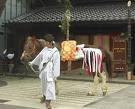[ . BACK to WORLDKIGO TOP . ]
:::::::::::::::::::::::::::::::::::::::::::::::::::::::::::::::::::::::::::::::::::::::::::::::::::
Kunimuke festival (oide matsuri)
Shrine Keta Taisha in Ishikawa
***** Location: Ishikawa, Japan
***** Season: Mid-Spring
***** Category: Observance
*****************************
Explanation
Oide matsuri 御出祭 (おいでまつり) "Departure Festival"
(Ode matsuri おでまつり【御出祭】) . 平国(おいで)祭
..... Kunimuke matsuri 平国祭(くにむけまつり)
Kunimuke Festival
(Keat Heikunisai 気多平国祭(けたへいこくさい))
:::::::::::::::::::::::::::::::::::::::::::::::::::::::::::::::::::::::::::::::::::::::::::::::::::
Shrine Keta Jinja 気多神社
 Keta taisha(気多大社 - Keta Big shrine)
Keta taisha(気多大社 - Keta Big shrine) is the head shrine of Noto district, in Hakui Town, Ishikawa prefecture.
The deity of this shrine is known as the god of love, and many young women come to wish for good love and marriage.
Dedicated to
Oanamuji no mikoto (大己貴命).
Festivals of the shrine: U-matsuri, Hirakuni-matsuri.
Many people have seen UFO flying from the back mountain of this shrine.
© More in the WIKIPEDIA !
:::::::::::::::::::::::::::::::::::::::::::::::::::::::::::::::::::::::::::::::::::::::::::::::::::::
quote
Mogi Sakae wrote:
A shinkōsai 神幸祭 (processional festival) held from March 18 to 23 at Keta Jinja 気多神社, Hakui City 石川県羽咋市 , Ishikawa Prefecture.

能登生國魂神社(氣多本宮) Keta Hongu
The festival name is also read
heikokusai 平国祭. It is a rite that recollects the territorial pacification exploits of the saijin (main enshrined kami) Ōnamuchi no mikoto.

A grand procession with a shinme (a horse upon which the kami rides 神馬) at the head makes a round trip from Keta Shrine to Ikukuni tamahiko Shrine 生国魂神社 in Nanao City, a trip of a hundred and several tens of kilometers lasting five nights and six days.
It is said that spring comes to the Noto region with this festival. Although in former times this used to be a rite in which a shin'yo (sacred palanquin) processed around the entire province, it is now limited to the counties of Hakui and Kajima.
In the procession the shinme is in the lead, with long-handled scythes, shrine name flags, rice chests, standards, shishinboko (four-kami pikes, shishin no hoko シジンノホコ 四神矛), bows and arrows, kunimuke hiroboko (wide-bladed kunimuke halberds 広矛(ひろほこ), and mounted priests in front and behind, protecting the shin'yo.
On the first day it travels around the northern area of Hakui County, stopping at Takiya Shrine in Hakui Town.
On the second day, the procession moves around the southern area and stops over night at the Inoyama Shrine in Inoyama Town.
On the third day it enters Kajima District and proceeds to the Noto Ikukunitamahiko Shrine. This is another name for Keta Jingū and is regarded as its original shrine.
When the shin'yo enters the shrine the people who have been accompanying it raise a shout and pour into the shrine precincts (keidai). The mounted priests proceed into the grounds as well.
However, in recent years, it is said that if they fall off their horses there will be an abundant harvest, so it has become quite wild.
On the fourth day they begin their return journey from Nanao to Kajima County, stopping at Shirahiko Shrine in Toriya Town.
On the fifth day they pass through the towns in the Noto area on their return to the main shrine (honsha). This is also called the
oide matsuri (Departure Festival). The shin'yo is enshrined in the haiden (worship hall) until the
Oisumi reisai (annual festival) on April 3.
Another name for this (latter) festival is the Eye of the Snake Rite (Ja no me shinji) in which a snake eye target representing the great serpent that Ōnamuchi no mikoto vanquished is destroyed with long swords, halberds and bows and arrows.
There is a
kunimuke festival on
May 21
at Hiraoka Jinja in Higashi Osaka City, Osaka Prefecture
河内枚岡神社.

In addition to the main ritual observance, at present the priests merely wave and offer halberds to the kami. The rite is said to originate in the myth relating the occasion of Nagasunehiko's prevention of Emperor Jinmu's eastern movement over Ikoma Mountain during the latter's pacification campaign of the Yamato region.
Formerly there was a ceremonial event in which participants went into the mountains in the evening to collect wood. Then they ran around striking the shrine buildings and the worship hall with the collected wood before returning home. In pre-modern times this occurred on February 1, but was abolished with the Meiji Resoration.
It was revived in the seventh year of the Taishō era (1918), and since then has been observed on the present festival day.
source : Kokugakuin University. 2006
:::::::::::::::::::::::::::::::::::::::::::::::::::::::::::::::::::::::::::::::::::::::::::::::::::::
Keta Taisha U Matsuri 気多大社鵜祭
Cormorant festival at Shrine Keta Taisha
December 16

Cormorants are set free before the festival and if they came back to the shrine ground, they were captured and set free at the nearby beach again.
:::::::::::::::::::::::::::::::::::::::::::::::::::::::::::::::::::::::::::::::::::::::::::::::::::::
Shrine Sukunahiko no kami kataishi jinja
宿那彦神像石神社(すくなひこのかみかたいし)

Takeminakata no kami 建御名方神(たけみなかたのかみ)
son of Oanamuji no mikoto
. Sukunahikona no mikoto 少彦名命 Sukuna Hikona, Sukuna-Hikona .
These two deities held a comparison of their powers by trying to destroy a poisonous snake from the region.

They used special weapons like sickles, which are in a tree trunk to our day.
鎌の宮神木 kama no miya shingi
::::::::::::::::::::::::::::::::::::::::::::::::::::::::::::::::::::::::::::::::::::::::::::::::::::::::::::::::::::::::::::::::::::
. yakuyoke 厄除け amulet against evil .
*****************************
Worldwide use
*****************************
Things found on the way
. jinme, shinba, shinme 神馬 sacred horses in Japan
*****************************
HAIKU
*****************************
Related words
*****
ukai 鵜飼 (うかい) cormorant fishing
BACK : Top of this Saijiki
[ . BACK to WORLDKIGO . TOP . ]
:::::::::::::::::::::::::::::::::::::::::::::::::::::::::::::::::::::::::::::::::::::::::::::::::::::






















